The letter Ṣād (ص) is one of the distinctive letters in the Arabic language, known for its emphatic sound and elegant, curved shape. Learning the forms of the letter Ṣād is essential for understanding how its shape changes depending on its position within a word. This understanding is a crucial step in teaching reading and writing, especially for children and beginners. In this lesson, we will explore the various forms of the letter Ṣād at the beginning, middle, and end of words, supported with practical examples and helpful exercises.
Understanding the Forms of the Arabic Letter sad (ص)

- The Form of Ṣād at the Beginning of a Word
When the letter Ṣād appears at the beginning of a word, it connects to the following letter and takes the form: صـ.
Examples: Sarookh (صاروخ), Ṣudfa (صدفة), Ṣadīq (صديق)
This is one of the most important forms of the letter sad, and children should be trained to recognize and write it properly, while associating it with its sound and appropriate vowel markings.

- The Form of Sad in the Middle of a Word
If the letter Ṣād occurs in the middle of a word, it connects to both the preceding and following letters, taking the form: ـصـ.
Examples: Kasr (قصر), Basal (بصل), ʿAsfar (أصفر)
This is a commonly used form of Ṣād in Arabic texts and requires regular practice through writing and pronunciation to be mastered correctly.

The Form of Ṣād at the End of a Word – Connected
When Ṣād comes at the end of a word and is connected to the letter before it, it is written as: ـص.
Examples: Meqas (مقص), Qamis (قميص), Qafas (قفص)
This form can be slightly challenging for beginners. Therefore, using flashcards and writing drills can help reinforce this shape in the learner’s memory.

The Form of Ṣād at the End of a Word – Isolated
If Sad appears at the end of a word and follows a letter that does not connect to it, it is written in its isolated form: ص.
Examples: Ghawas (غواص), Sos (صوص)
This form closely resembles the one used at the beginning of a word, making it easier for children to recognize and reproduce with confidence.

It is important to train learners to distinguish between Letter Sad (ص) and similar letters such as Ḍād (ض). The primary visual difference is the presence of a dot above the Ḍād. Visual recognition and auditory differentiation exercises are essential in helping students understand the forms of the letter Ṣād accurately and avoid spelling mistakes.